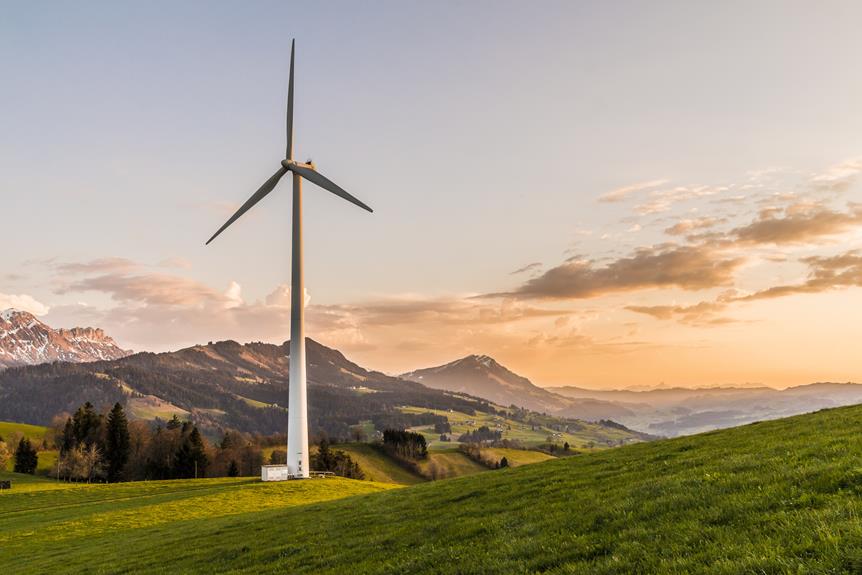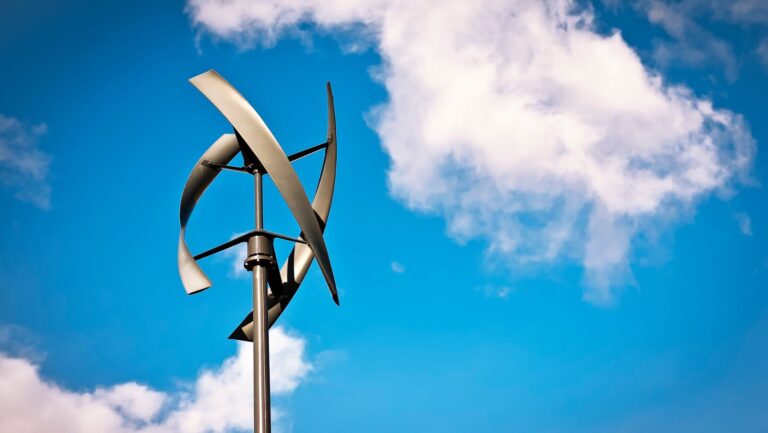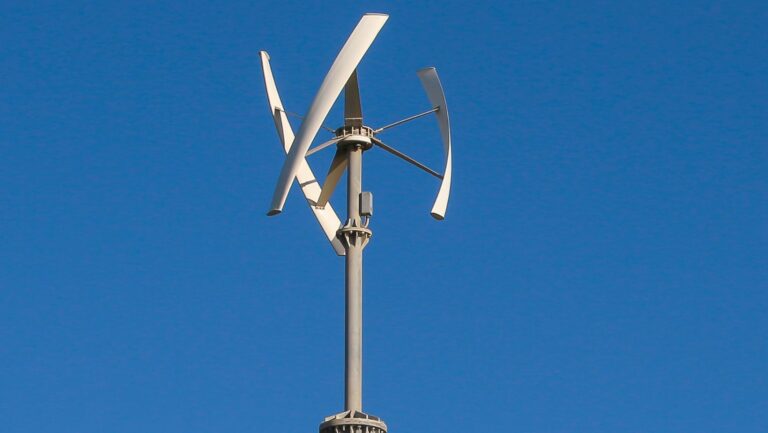11 Key Steps to Troubleshoot Home Wind Turbine Issues
Like a skilled mechanic diagnosing a complex engine problem, you can troubleshoot and fix issues with your home wind turbine. In this article, we will guide you through 11 key steps to identify and resolve common home wind turbine issues.
From inspecting the blades to testing the inverter, we’ll provide you with the knowledge and tools you need to keep your wind turbine running smoothly.
Get ready to become a wind turbine troubleshooting pro!
Inspect the Turbine Blades
Inspect the turbine blades by visually examining them for any signs of damage or wear. Start by carefully observing each blade, paying close attention to its leading and trailing edges, as well as the surface area. Look for any cracks, chips, or erosion that may compromise the blade’s structural integrity. If you notice any significant damage, it’s crucial to proceed with blade repair promptly.
Additionally, inspect the blades for any dirt, debris, or bird droppings that may have accumulated. Regular blade cleaning is essential to maintain optimal performance and prevent unnecessary strain on the turbine. Use appropriate cleaning methods and tools to ensure the blades are free from any contaminants.
Check the Electrical Connections
To troubleshoot issues with your home wind turbine, it’s important to check the electrical connections. Loose wire connections can lead to power fluctuations and decreased efficiency.
Additionally, faulty circuitry can cause issues with the turbine’s overall performance. By inspecting and ensuring the integrity of the electrical connections, you can identify and resolve any potential issues that may be affecting your turbine’s operation.
Loose Wire Connections
To troubleshoot loose wire connections in your home wind turbine, start by thoroughly inspecting the electrical connections.
Begin by checking the wire insulation for any signs of wear or damage. Look for frayed or exposed wires, as these can lead to loose connections. If you notice any issues with the wire insulation, it’s important to replace the affected wires to ensure a secure connection.
Additionally, inspect the connections for any signs of corrosion. Corrosion can cause poor conductivity and result in loose connections. If you find any corrosion, clean the affected area using a wire brush and apply a corrosion-resistant coating.
Remember to tighten any loose connections and secure them properly. Taking these steps will help maintain the efficiency and safety of your home wind turbine system.
Faulty Circuitry
Now, let’s address the issue of faulty circuitry in your home wind turbine system, ensuring the smooth functioning and reliability of your electrical connections. Here are the key steps to take:
- Inspect the wiring: Examine all the electrical connections in your wind turbine system, checking for loose or frayed wires. Replace any damaged wires or connectors to ensure a secure and reliable connection.
- Check for overheating: Overheating can indicate a faulty circuitry issue. Inspect all components, such as inverters and controllers, for signs of excessive heat. If any components are abnormally hot, replace them immediately to prevent further damage.
- Test voltage and current: Use a multimeter to measure the voltage and current at different points in your wind turbine system. Compare the readings to the manufacturer’s specifications to identify any discrepancies that may indicate faulty circuitry.
- Replace faulty components: If you detect any faulty components during your troubleshooting process, such as damaged circuit boards or blown fuses, replace them promptly with new ones to restore the functionality of your wind turbine system.
Power Output Fluctuations
If you’re experiencing power output fluctuations in your home wind turbine system, you should check the electrical connections for any issues. Power output fluctuations can occur due to loose or faulty electrical connections that can disrupt the flow of electricity from the turbine to your home.
To troubleshoot this issue, start by inspecting all the electrical connections in your wind turbine system. Ensure that all connections are secure and tight. Look for any signs of corrosion or damage, and clean or replace any affected connectors. Additionally, check the wiring for any frayed or damaged sections and repair or replace as necessary.
Regular wind turbine maintenance, including checking and maintaining the electrical connections, is crucial to ensure optimal performance and prevent power output fluctuations.
Assess the Wind Speed and Direction
First, determine the wind speed and direction at your home wind turbine site. This is crucial in optimizing the performance of your wind turbine. Here are four steps to assess the wind speed and direction:
- Use an anemometer: Attach an anemometer to a secure location near your turbine to measure wind speed. This device will provide accurate real-time readings.
- Install wind direction indicators: Place wind direction indicators on top of your turbine or nearby structures. These indicators will help you determine the direction from which the wind is blowing.
- Observe surrounding vegetation: Look for signs of wind direction, such as bent or swaying trees and grass. This can give you a general idea of wind patterns in your area.
- Check online resources: Utilize online weather platforms that provide wind speed and direction data specific to your location.
Examine the Tower Structure
Are you examining the tower structure of your home wind turbine? The stability and maintenance of the tower are crucial for the overall performance and safety of your system.
Start by visually inspecting the tower for any signs of damage, such as corrosion, loose bolts, or cracks. Ensure that the foundation is solid and there are no signs of sinking or shifting.
Check the guy wires or anchors for tension and make sure they’re properly secured. Additionally, inspect the tower’s guy wire connections and tighten any loose fittings.
Regularly perform maintenance tasks like lubricating the tower’s moving parts and conducting routine inspections to prevent any potential issues.
Proper tower maintenance won’t only enhance the performance of your wind turbine but also ensure the safety of your home and surroundings.
Monitor the Generator Output
To monitor the generator output of your home wind turbine, connect an ammeter to the system and observe the current being produced. This will give you valuable information about the performance of your turbine and help you identify any issues that may be affecting its efficiency.
Here are four important things to keep in mind when monitoring the generator output:
- Consistency: Check the ammeter regularly to ensure a consistent and stable current output. Fluctuations in the current may indicate a problem with the generator or other components of the system.
- Wind Speed Measurement: Take note of the wind speed during the time of the current measurement. This will help you determine whether the current output is in line with the expected performance for the given wind conditions.
- Generator Maintenance: Regularly inspect and maintain the generator to ensure optimal performance. Clean any debris or dirt that may have accumulated on the blades or other parts of the turbine.
- Record Keeping: Keep a record of the current output over time. This will allow you to track any changes or trends in the performance of your wind turbine and identify any potential issues that may require attention.
Evaluate the Battery System
To evaluate the battery system of your home wind turbine, you need to pay attention to battery voltage fluctuations. This can indicate issues with the charging or discharging process. Understanding how the system operates is crucial for troubleshooting.
Additionally, it is important to understand the charging and discharging process. This will help you identify any potential issues and ensure that the battery is functioning properly.
Following proper battery maintenance tips is also essential. Regular maintenance, such as checking the electrolyte levels and cleaning battery terminals, will help ensure optimal performance and longevity of your battery system.
Battery Voltage Fluctuations
How can you evaluate the battery system to troubleshoot home wind turbine issues caused by battery voltage fluctuations?
- Check battery life: Start by examining the age and condition of the battery. If it’s old or damaged, it may not be able to hold a stable voltage, leading to fluctuations.
- Test voltage regulation: Measure the voltage output of the battery using a multimeter. Compare the readings to the manufacturer’s specifications to ensure it’s within the acceptable range.
- Inspect wiring connections: Examine the wiring connections between the wind turbine and the battery. Loose or corroded connections can cause voltage fluctuations.
- Monitor charging process: Observe the charging process of the battery. If the wind turbine isn’t generating enough power or the charging controller is malfunctioning, it can result in inconsistent voltage levels.
Charging and Discharging
Assess the battery’s charging and discharging processes to effectively evaluate the battery system for troubleshooting home wind turbine issues.
The charging efficiency of the battery is crucial in ensuring that it receives the necessary power from the wind turbine. A low charging efficiency can result in insufficient power being stored, leading to a shorter battery lifespan. It’s important to monitor the charging process and ensure that the battery is receiving the optimal amount of power.
Similarly, the discharging process should be evaluated to ensure that the battery is supplying power efficiently to the home’s electrical system. If the battery’s charging and discharging processes aren’t functioning properly, it can lead to issues such as power outages or reduced power output.
Regularly assessing these processes will help identify any potential problems and allow for timely troubleshooting.
Battery Maintenance Tips
Evaluate the battery system by regularly maintaining it to ensure optimal performance and longevity. Here are some battery maintenance tips to help you get the most out of your home wind turbine system:
- Check the battery voltage regularly to ensure it’s within the recommended range. This will help you identify any issues with the battery and take appropriate action.
- Clean the battery terminals and connections to remove any dirt or corrosion. This will help maintain good electrical contact and prevent power loss.
- Inspect the battery for any signs of damage or leakage. If you notice any issues, it may be necessary to replace the battery to avoid further damage to the system.
- Keep track of the battery lifespan and monitor its performance over time. Most batteries have a limited lifespan and will eventually require replacement. By keeping an eye on the battery’s performance, you can plan for a replacement before it fails.
Review the Controller Settings
To effectively troubleshoot issues with your home wind turbine, start by reviewing the settings of the controller.
The controller is a crucial component that regulates the operation of the turbine and ensures optimal performance. Begin by checking the controller calibration to ensure it’s accurately measuring the wind speed and adjusting the turbine accordingly. If the calibration is off, it can lead to inefficient operation or even damage to the turbine.
Next, familiarize yourself with the troubleshooting techniques specific to your controller model. This may involve checking error codes, analyzing data logs, or following step-by-step instructions provided by the manufacturer.
Investigate the Brake System
Check the brake system for any potential issues. The brake system is a critical component of your home wind turbine, and regular maintenance and troubleshooting are essential to ensure its proper functioning.
Here are some steps to help you with brake system maintenance and troubleshooting:
- Inspect the brake pads: Check for wear and tear on the brake pads. If they’re worn out, replace them immediately to maintain the braking efficiency.
- Examine the brake disc: Look for any signs of damage or warping on the brake disc. A damaged disc may lead to poor braking performance and should be replaced promptly.
- Check the brake caliper: Ensure that the brake caliper is functioning correctly. Look for any signs of leakage or corrosion. If you notice any issues, repair or replace the caliper as needed.
- Test the brake control mechanism: Check the brake control mechanism for proper operation. Ensure that it engages and disengages smoothly. If you encounter any problems, consult the manufacturer’s instructions or seek professional assistance.
Test the Inverter Functionality
Now it’s time to test the functionality of your wind turbine’s inverter. This crucial component converts the direct current (DC) produced by the turbine into alternating current (AC) that can be used to power your home.
If your inverter isn’t working properly, it can lead to a range of issues, such as power fluctuations or even a complete shutdown of the system.
In this section, we’ll discuss some common inverter malfunctions and provide troubleshooting tips to help you identify and resolve any problems.
Inverter Troubleshooting Tips
Ensure the functionality of your inverter by testing its performance. Here are some inverter troubleshooting tips to help you identify and resolve common inverter problems:
- Check the display: Inspect the inverter’s display to see if any error codes or warning messages are being displayed. These can provide valuable information about the specific issue.
- Test the connections: Make sure all the cables and connections are securely attached. Loose or damaged connections can cause power interruptions or inefficient performance.
- Monitor the output voltage: Measure the voltage output of the inverter using a multimeter. Compare it to the expected voltage range specified by the manufacturer. If there’s a significant difference, it may indicate a faulty inverter.
- Consult the manual: Refer to the inverter’s user manual for troubleshooting guidance specific to your model. It will provide detailed instructions on identifying and resolving common issues.
Common Inverter Malfunctions
To test the functionality of your inverter and identify common malfunctions, start by monitoring the output voltage using a multimeter. Connect the multimeter to the inverter’s output terminals and measure the voltage. A properly functioning inverter should provide a stable and consistent output voltage. If the voltage readings are erratic or significantly lower than expected, it may indicate a problem with the inverter.
Troubleshooting battery issues should also be considered when dealing with inverter malfunctions. Check the battery connections and ensure they’re secure and free from corrosion. Inspect the battery for any signs of damage or deterioration. If the battery is old or not functioning properly, it may not be supplying enough power to the inverter, resulting in malfunctions.
Verify Proper Grounding
You should check for proper grounding in your home wind turbine. Proper grounding is essential for the safe and efficient operation of your turbine. Here are the steps to verify proper grounding:
- Inspect the grounding connection: Check that all grounding wires are securely connected to the turbine and the grounding rod. Look for any loose or damaged connections that could affect the grounding effectiveness.
- Test the grounding resistance: Use a ground resistance tester to measure the resistance between the turbine’s grounding system and the earth. A low resistance value indicates a good grounding system.
- Troubleshoot vibration issues: Vibrations in the turbine can sometimes be caused by a lack of proper grounding. If you’re experiencing excessive vibrations, ensure that the turbine is properly grounded to eliminate this as a potential cause.
- Consult a professional: If you’re unsure about the grounding inspection or encounter any issues, it’s best to consult a professional electrician or wind turbine technician for further guidance.
Troubleshoot Noise and Vibration Issues
Inspecting the turbine for any signs of excessive noise and vibration can help troubleshoot potential issues.
If you notice any unusual sounds or vibrations coming from the turbine, it’s important to address them promptly to prevent further damage.
One possible cause of noise and vibration issues is lubrication problems. Inspect the turbine’s lubrication system and check for leaks or inadequate lubricant levels. Troubleshoot any lubrication issues by ensuring proper lubricant is being used and that it’s applied to all necessary components.
Another potential cause of noise and vibration is mechanical wear. Carefully inspect all moving parts of the turbine, such as the blades, shaft, and bearings, for signs of wear or damage. Identifying mechanical wear early on can prevent more serious issues from occurring and help maintain the efficiency of the turbine.
Conclusion
So, after following these 11 key steps to troubleshoot your home wind turbine issues, you should be all set, right? Well, maybe not. Despite our informative and technical guide, the world of wind turbines can still be a whirlwind of surprises. But hey, at least now you have a better understanding of what to look out for.
Happy troubleshooting!






